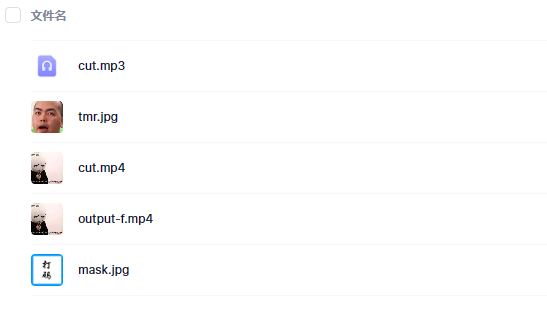溫馨提示×
您好,登錄后才能下訂單哦!
點擊 登錄注冊 即表示同意《億速云用戶服務條款》
您好,登錄后才能下訂單哦!
這篇文章主要介紹了Python如何實現人臉識別并進行視頻跟蹤打碼的相關知識,內容詳細易懂,操作簡單快捷,具有一定借鑒價值,相信大家閱讀完這篇Python如何實現人臉識別并進行視頻跟蹤打碼文章都會有所收獲,下面我們一起來看看吧。
首先需要一些素材,大家可以自己準備

這個是要用的工具

使用的模塊
import cv2 import face_recognition import matplotlib.pyplot as plt # %matplotlib inline # 在 jupyter 中使用的時候,去掉注釋 import ffmpy3 import subprocess import os from PIL import Image
將視頻轉為音頻
def video2mp3(file_name):
outfile_name = file_name.split('.')[0] + '.mp3'
cmd = 'ffmpeg -i ' + file_name + ' -f mp3 ' + outfile_name
print(cmd)
subprocess.call(cmd, shell=True)視頻添加音頻
def video_add_mp3(file_name, mp3_file):
outfile_name = file_name.split('.')[0] + '-f.mp4'
subprocess.call('ffmpeg -i ' + file_name
+ ' -i ' + mp3_file + ' -strict -2 -f mp4 '
+ outfile_name, shell=True)主要代碼
def mask_video(input_video, output_video, mask_path='mask.jpg'):
# 打碼圖片
# 完整源碼、視頻講解
# Python學習交流群:708525271
# 直接加它領取
mask = cv2.imread(mask_path)
# 讀取視頻
cap = cv2.VideoCapture(input_video)
# 讀取視頻參數,fps、width、heigth
CV_CAP_PROP_FPS = 5
CV_CAP_PROP_FRAME_WIDTH = 3
CV_CAP_PROP_FRAME_HEIGHT = 4
v_fps = cap.get(CV_CAP_PROP_FPS)
v_width = cap.get(CV_CAP_PROP_FRAME_WIDTH)
v_height = cap.get(CV_CAP_PROP_FRAME_HEIGHT)
# 設置寫視頻參數,格式為 mp4
size = (int(v_width), int(v_height))
fourcc = cv2.VideoWriter_fourcc('m', 'p', '4', 'v')
out = cv2.VideoWriter(output_video, fourcc, v_fps, size)
# 已知人臉
known_image = face_recognition.load_image_file("tmr.jpg")
biden_encoding = face_recognition.face_encodings(known_image)[0]
# 讀取視頻
cap = cv2.VideoCapture(input_video)
while (cap.isOpened()):
ret, frame = cap.read()
if ret:
# 檢測人臉
face_locations = face_recognition.face_locations(frame)
# print(face_locations)
# 檢測每一個人臉
for (top_right_y, top_right_x, left_bottom_y, left_bottom_x) in face_locations:
unknown_image = frame[top_right_y - 50:left_bottom_y + 50, left_bottom_x - 50:top_right_x + 50]
print(face_recognition.face_encodings(unknown_image))
if face_recognition.face_encodings(unknown_image) != []:
unknown_encoding = face_recognition.face_encodings(unknown_image)[0]
# 對比結果
results = face_recognition.compare_faces([biden_encoding], unknown_encoding)
# 是仝卓,就將打碼貼圖。
if results[0] == True:
mask = cv2.resize(mask, (top_right_x - left_bottom_x, left_bottom_y - top_right_y))
frame[top_right_y:left_bottom_y, left_bottom_x:top_right_x] = mask
# 寫入視頻
out.write(frame)
else:
break將音頻保存為cut.mp3
video2mp3(file_name='cut.mp4')
處理視頻,自動打碼,輸出視頻為output.mp4
mask_video(input_video='cut.mp4', output_video='output.mp4')
為 output.mp4 處理好的視頻添加聲音
video_add_mp3(file_name='output.mp4', mp3_file='cut.mp3')
關于“Python如何實現人臉識別并進行視頻跟蹤打碼”這篇文章的內容就介紹到這里,感謝各位的閱讀!相信大家對“Python如何實現人臉識別并進行視頻跟蹤打碼”知識都有一定的了解,大家如果還想學習更多知識,歡迎關注億速云行業資訊頻道。
免責聲明:本站發布的內容(圖片、視頻和文字)以原創、轉載和分享為主,文章觀點不代表本網站立場,如果涉及侵權請聯系站長郵箱:is@yisu.com進行舉報,并提供相關證據,一經查實,將立刻刪除涉嫌侵權內容。